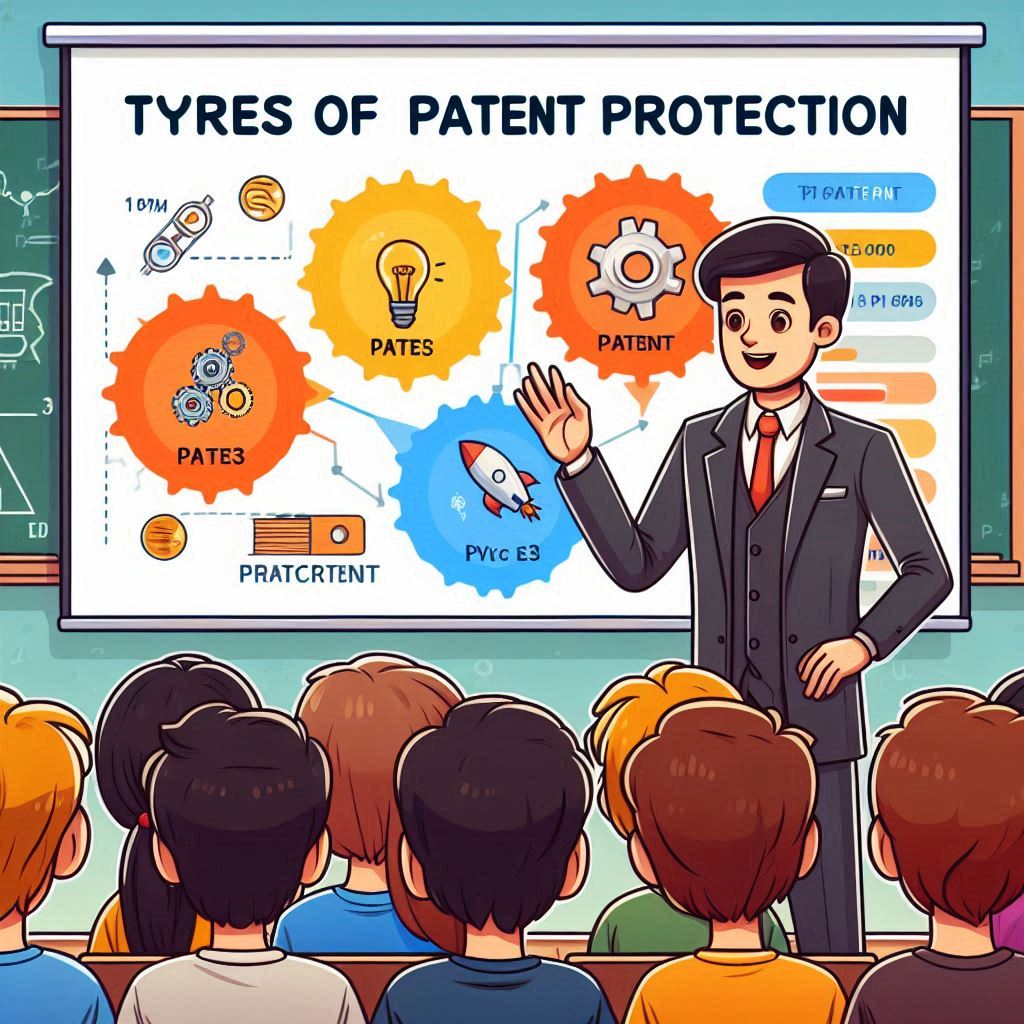In today’s fast-moving technological world, patents play a large part in protecting any invention or innovation.
It gives the creator of the invention exclusive rights over that invention, thereby protecting and furthering innovation by giving them the chance to profit from their work.
However, do you know that there is not just one kind of patent? There are three kinds of patent protection available for inventors and innovators.
In this all-inclusive guide, we will look at the three types of patent protection: utility patents, design patents, and plant patents.

We will go ahead to discuss exactly what each one covers, how they are different, and when you might want to use each one.
By the time we get to the end of this article, you will have an idea of the different patent options available to you and how they might help in protecting your intellectual property.
And with that, the journey into the world of patent protection begins!
Utility Patents: The Workhorses of Patent Protection
What Are Utility Patents?
Utility patents are the most common kind of patent protection, covering new and useful processes, machines, manufacture, or compositions of matter. Said differently, utility patents protect how something works or how it’s used. These are often referred to as “patents for invention” because they protect the functional aspects of an invention.
Utility Patents—Key Features
- Term: It is 20 years in length, starting from the filing date of the patent application.
- Scope: A utility patent may encompass any new and useful process, machine, manufacture, or composition of matter.
- Requirements: The invention must be new, least obvious, and it has some use for utility patents.
Some Examples of Utility Patents:
- A newly designed, longer-lasting smartphone
- A more cost-effective means of manufacturing alternative energy
A new pharmaceutical compound to treat a specific disease
When to Use Utility Patents
Utility patents are most suited for protecting inventions having an application or which help remedy a specific problem. As long as you have made an invention that serves a function or possesses an object value, then utility patents are more likely applicable. Intellectual value is very important in industries such as technology and manufacturing, as well as in biotechnology.

Application for Utility Patents Basically, the process involved in applying for a utility patent can be broken down into the following: A search: to determine the novelty of the idea. Preparing: and applying for the USPTO. The application will then be analyzed: by the patent examiner. Submissions of responses: to the objection or rejection of the examiner, if there were any. The patent, finally becomes: an official trademark after the issue fee is paid, and upheld through classification maintenance fees.
While the process may be complicated and rather time-consuming, this protection a utility patent affords is invaluable to the inventor and business enterprise alike.
Design Patents: Protecting the Look of Your Invention
What Are Design Patents?
While utility patents address the functional features of an invention, design patents concern themselves with the ornamental appearance of the invention. They protect new, original, and ornamental designs for an article of manufacture. Design patents protect the visual characteristics of a product, not functional aspects.
The Basic Features of Design Patents:
- Term: Design patents have a term of 15 years from the date of grant for applications filed on or after May 13, 2015.
- Subject Matter: They protect the ornamental appearance of an article, including its shape, configuration, or the surface ornamentation done on an object
- Requirements: The design to be patented must be novel, original, and non-obvious
Examples of Design Patents:
A new and unique design of a Smartphone
Distinct ornamentation on a piece of furniture
The pattern on the sole of a shoe
When to Use Design Patents
Design patents can be very effective for products where the look and feel of the product is a primary selling point. They have proven very effective in industries such as fashion, product design, and consumer goods. If you have created a unique-looking product that differentiates itself from others in its marketplace, then a design patent can help secure this advantage.
Process for a Design Patent Application
The design patent follows the process of obtaining a utility patent, alongside its exception in the following ways:
- Detailed drawing of a design;
- Application of a design for the design patent with USPTO;
- The examination of the patent by the Patent Examiner;
- Reply to objection or rejection, if any.
- Payment for the issue fee in case of approval.
On average, design patent applications usually make it through the system faster than utility patents and take approximately 12-18 months from filing to grant.
Plant Patents: Protecting Nature’s Innovations
What Are Plant Patents?
Plant patents are the least common of the three types of patent protection. They include new varieties of asexually reproduced plants. This kind of patent protects the rights of plant breeders who develop new and distinct varieties of plants.

Key Aspects of Plant Patents:
- Term: Plant patents last for 20 years from the date on which the application for the patent is filed.
- Geographical coverage: One single variety of asexually-reproduced plant
- Conditions: To qualify for a plant patent, the plant must be novel, distinctly different from any known plant, and not an apparent variation of an existing plant species
Sample Description of Plant Patents:
For instance, a decision can be made to grant a plant patent upon an application to a new variety of rose, which differs from all other varieties of roses known to exist due to its petals’ unique
A new type of fruit tree with increased yield
When to Consider Applying for a Plant Patent
Plant patents are one of the most narrowly focused applications available, intended only for those in very specific professions directly related to horticulture, agriculture, and plant development. If you have developed a new type of plant through the process of reproduction known as grafting or cutting, a plant patent can protect the investment of money, time, and work made developing the new variety.
How to Get a Plant Patent
There are some differences in applying for a plant patent, which include:
- If the exclusive features must be preserved, asexually reproduce the plant.
- Write a complete botanical description regarding the plant and its features that are distinguishable.
- Apply for a plant patent with the USPTO.
- Wait to be examined by a patent examiner.
- Answer any objections or rejections from the examiner.
- After allowance, pay the issue fee.
Plant patent applications almost always involve specialized knowledge so most often one engages the services of a patent attorney who does a plant specialty.
Comparing the Three Types of Patent Protection
Now that we have walked through each type of protection on its own, we can compare all three of them side by side and highlight their most apparent differences:
- Subject Matter:
• Utility Patents: The functional features of an invention.
• Design Patents: Ornamental design of manufactured articles.
• Plant Patents: New varieties of asexually reproduced plants. - Duration:
- Utility Patents: 20 years from the filing date
- Design Patents: 15 years from the grant date
- Plant Patents: 20 years from filing date
- Requirements:
- Utility Patents: Novel, non-obvious, and useful
- Design Patents: New, original, and non-obvious
- Plant Patents: New, distinct, and non-obvious
- Typical Industries:
- Utility Patents: Technology, manufacturing, biotechnology
– Design Patents: Fashion, product design, consumer goods
– Plant Patents: Agriculture, horticulture, plant breeding
- Protection Scope:
– Utility Patents: How something works or is used
– Design Patents: How something looks
– Plant Patents: A specific plant variety
Selecting the Appropriate Type of Patent Protection
There are several factors upon which the appropriate type of patent protection relies:
- Nature of Your Invention: Consider whether the main nature of your invention is functional, aesthetic, or a new variety of plants.
- Industry: A tendency exists for some kinds of patents to be required by specific industries.
- Budget: Be informed that patent applications and all subsequent renewals come with varying costs.
- Long-Term Goals: Consider what aspects of your invention you will be using to enter the market and what it is that requires protection.
- Market Strategy: Consider how patent protection fits into your overall business and marketing strategy.
In some cases, you may need to acquire more than one type of patent protection. For example, a new smartphone would be protected by utility patents for its functional features and design patents for its unique appearance.
Why Patent Protection in Innovation is Imperative
No matter what form it takes, patent protection forms a crucible for innovation and economic growth. Here is why:
- Incentivizes Innovation: Exclusive rights, through patents, encourage inventors to invest time and resources in developing new ideas.
- Disclosure: In return for this protection, the inventions have to be publicly disclosed by the inventor. This adds to the base of common knowledge.
- Facilitates Commercialization: A patent can make it easier to attract investors, license technology, or sell inventions.
- Protecting Market Share: Companies can dominate the market thanks to some protection from a patent that ensures businesses maintain a leading edge in the market.
- Stimulates Economic Development: The patent system is a key engine for technological progress and economic development.
Common Myths about Patent Protection
As we are about to finish our discussion on the different forms of patents, it is only appropriate to clear up some common myths:
- “A patent gives me the right to make my invention.” A patent permits you to exclude others from making, using, or selling your invention.
- “Patents are valid worldwide.” Patents are territorial. You need to file for protection in each country where you want rights.
- “Once I have a patent, I don’t need to do anything else.” Patents require maintenance fees and active enforcement to remain effective.
- “I can patent an idea.” Patents protect specific inventions, not abstract ideas.
- “All patents last for 20 years.” As we’ve seen, design patents have a different duration than utility and plant patents.
Conclusion
Inventors, entrepreneurs, and businesses should be aware of the different types of protection: a utility patent, a design patent, and a plant patent. The three types protect different features or aspects of an invention.
The most common are utility patents, which protect how things work and are used. Utility patents would be particularly useful for functional inventions within a wide array of industries. Design patents protect the ornamental appearance of manufactured articles; given this fact, they are valuable, for instance, in those industries where the aesthetic values are at the top. Plant patents are less common but very important for those who develop new varieties of plants.
The right sort of protection for your invention, however, will depend on the nature of your invention, your industry, and your long-term goals. In some cases, you might even need multiple types of protection to fully safeguard your innovation.
Though arduous due to the complexity swirling around the patent application process, in the end, the gain from its protection is enormous. Patents safeguard not only your ideas but also are part of the general panorama of innovation and economic development.
With those kinds of patent protections in mind, let your innovation journey begin. They are incredibly powerful ways to achieve what you want with your creative ideas and success in the fiercely competitive world of inventions and entrepreneurship.






